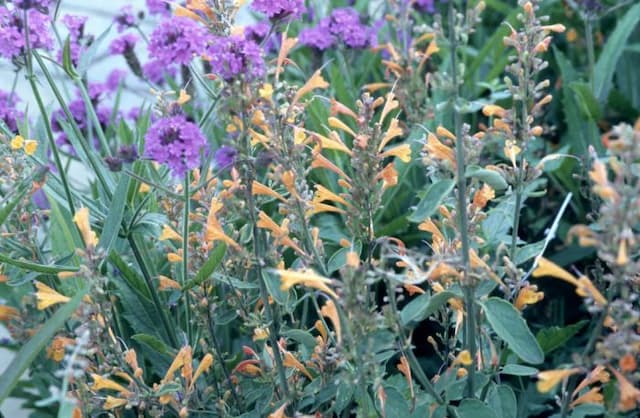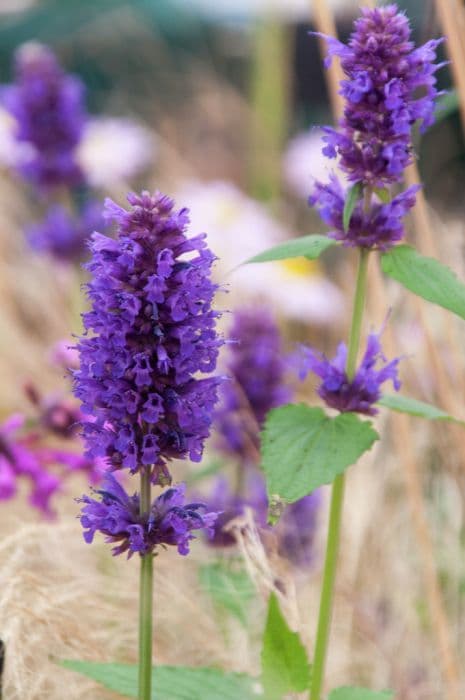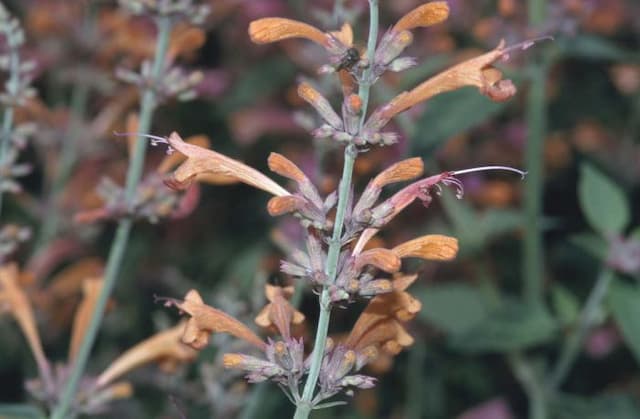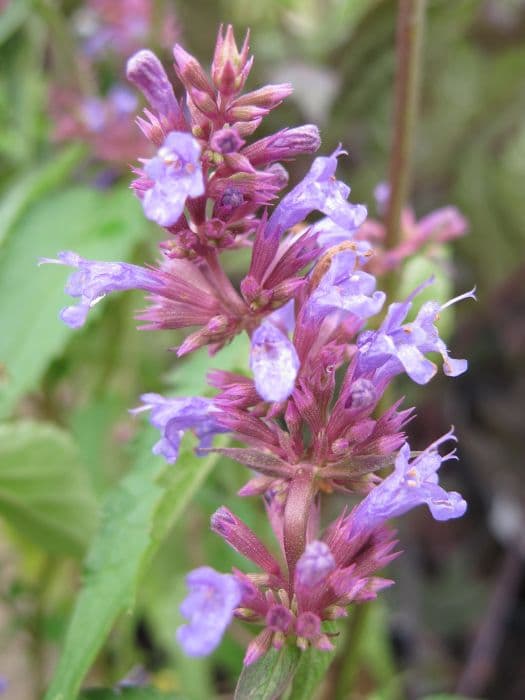French Lavender Lavandula stoechas subsp. stoechas f. rosea 'Kew Red'

ABOUT
The plant commonly known as 'Kew Red' Spanish Lavender features distinctive deep pink to magenta flower bracts, which resemble small, slender pineapples or tufts and are topped with delicate, petal-like extensions that are a darker hue than the bracts. Below these showy bracts are tubular, purple flowers that add to the color contrast and visual interest. The foliage is gray-green, often with a fine, velvety texture, forming a dense, aromatic mound that complements the vivid flowers. The leaves are typically narrow, elongated, and slightly toothed on the edges. The blooms of 'Kew Red' Spanish Lavender emit a strong, sweet fragrance that is appealing to both humans and pollinators such as bees and butterflies. The overall appearance of the plant is one of vibrant color and rustic charm, making it a highly attractive feature in any garden setting.
About this plant
 Names
NamesFamily
Lamiaceae.
Synonyms
French Lavender, Spanish Lavender, Butterfly Lavender, Kew Red Lavender.
Common names
Lavandula stoechas subsp. stoechas f. rosea 'Kew Red'.
 Toxicity
ToxicityTo humans
Spanish lavender (the most common name for Lavandula stoechas) generally has a low level of toxicity to humans. Ingesting it in small quantities typically does not cause serious harm. However, consuming large amounts could potentially lead to gastrointestinal discomfort, nausea, vomiting, or diarrhea. The plant contains essential oils and compounds like camphor, linalool, and others that can irritate the digestive system. Adverse skin reactions are also possible if one is allergic to its constituents. It is recommended to use this plant only as intended, such as for ornamental purposes or as a culinary herb in modest amounts.
To pets
Spanish lavender is considered non-toxic to pets including dogs and cats. While it does contain essential oils and compounds that could potentially cause mild gastrointestinal upset if ingested in large quantities, typical household exposure is unlikely to result in severe poisoning. Pets may experience mild vomiting or diarrhea if they consume a significant amount of the plant. As a precaution, it's always best to prevent your pets from ingesting ornamental plants, as individual animals may have unique sensitivities or allergic reactions.
 Characteristics
CharacteristicsLife cycle
Perennials
Foliage type
Evergreen
Color of leaves
Gray-green
Flower color
Red
Height
1-2 feet (30-60 cm)
Spread
2-3 feet (60-90 cm)
Plant type
Shrub
Hardiness zones
8
Native area
Mediterranean
Benefits
 General Benefits
General Benefits- Aesthetic Appeal: 'Kew Red' Spanish lavender adds a unique color accent to gardens with its rose-pink flower spikes, unlike the more typical purple of lavender varieties.
- Fragrance: This cultivar retains the signature strong and pleasant scent of lavender that can perfume an outdoor space or be used in sachets for a lingering fragrance indoors.
- Attract Pollinators: It is attractive to bees, butterflies, and other beneficial pollinators, which are essential for the pollination of many plants and overall garden health.
- Drought Tolerance: Once established, 'Kew Red' Spanish lavender has low water requirements, making it a good choice for xeriscaping and water-wise gardens.
- Low Maintenance: This plant requires minimal care once established, needing only occasional pruning and infrequent watering.
- Deer Resistance: Lavender is generally resistant to deer, which makes 'Kew Red' a good choice for gardens in areas with a high deer population.
 Medical Properties
Medical Properties- Antiseptic: Commonly used in essential oils that have antiseptic properties, which can help clean and protect against infection.
- Anti-inflammatory: The plant's essential oil is known to have anti-inflammatory effects, which could be beneficial in reducing inflammation and related pain.
- Anxiolytic: Lavender is reputed to have a calming effect that can alleviate stress and anxiety, promoting relaxation and better sleep.
- Antispasmodic: May help relieve muscle spasms and cramps due to its antispasmodic properties.
- Analgesic: Some components of lavender oil are thought to possess analgesic, or pain-relieving, properties.
 Air-purifying Qualities
Air-purifying QualitiesThis plant is not specifically known for air purifying qualities.
 Other Uses
Other Uses- Dried French lavender (Lavandula stoechas subsp. stoechas f. rosea 'Kew Red') flowers and buds can be used to create a natural dye, which imparts a soft purple hue to fabrics and materials.
- Essential oil from French lavender can be mixed with water to make a natural disinfectant spray for cleaning surfaces in the home, having a pleasant aroma as an added benefit.
- The intense colors and pleasant scent of French lavender can be utilized in potpourri mixtures, providing both visual appeal and a natural freshener to rooms.
- French lavender can be incorporated into homemade paper, adding specks of color and a subtle fragrance to the final product.
- The long-lasting scent of French lavender makes it a suitable natural moth repellent for wardrobes and drawers, safeguarding clothes from damage.
- French lavender can be used in crafting homemade candles, imparting a soothing fragrance that enhances the ambiance of living spaces.
- When infused into oils or waxes, French lavender can act as a natural leather conditioner, providing a gentle fragrance to leather goods.
- Fresh French lavender can serve as an eco-friendly confetti alternative at celebrations, biodegrading over time without harming the environment.
- French lavender flowers can be pressed and used in botanical art, preserving their form and color for decorative purposes.
- When woven into wreaths or garlands, dried French lavender adds a rustic and aromatic touch to home decor or events like weddings.
Interesting Facts
 Feng Shui
Feng ShuiThe plant Lavender is not used in Feng Shui practice.
 Zodiac Sign Compitability
Zodiac Sign CompitabilityThe plant Lavender is not used in astrology practice.
 Plant Symbolism
Plant Symbolism- Calming and Relaxation: Like other forms of lavender, 'Kew Red' Spanish lavender is symbolic of calmness and relaxation, often used in aromatherapy for its soothing scent that is believed to alleviate stress and anxiety.
- Purity and Silence: Lavender in general has been associated with purity and the virtue of silence, partly due to its delicate appearance and its use in purifying sacred spaces historically.
- Devotion and Love: Lavender can also represent devotion and an expression of love, making it a thoughtful gift for couples or a symbol used in weddings to signify a lifelong commitment.
- Healing and Protection: Traditionally, lavender was believed to have protective and healing properties, so this plant could symbolize the wish for someone’s well-being or to ward off evil spirits.
 Water
WaterFrench lavender 'Kew Red' needs to be watered deeply yet infrequently, with a general rule being to allow the soil to dry out between waterings. You should aim to give the plant about 1 gallon of water every 1-2 weeks during the growing season, depending on the climate and the soil's moisture retention characteristics. In the cooler months, water even less, paying close attention to the plant's response to watering by observing the foliage and soil moisture. Overwatering could lead to root rot, so it's crucial to provide good drainage. Adjust the volume and frequency based on weather conditions; more water may be necessary during hot, dry periods and less during cool, damp periods.
 Light
LightFrench lavender 'Kew Red' thrives best in full sun conditions, requiring at least 6 hours of direct sunlight daily. The ideal spot for planting is an area that receives unfiltered sunlight throughout the day. If grown indoors, a south-facing window is usually a good location, but make sure it also gets adequate air circulation.
 Temperature
TemperatureFrench lavender 'Kew Red' prefers warm temperatures and does well in a range between 60-70 degrees Fahrenheit. It can survive temperatures as low as 10 degrees Fahrenheit, but the ideal growing conditions are warm and not humid. To prevent frost damage, provide protection or move the plant indoors if temperatures are expected to fall below the 10 degrees Fahrenheit threshold.
 Pruning
PruningFrench lavender 'Kew Red' should be pruned to promote vigorous growth and prevent it from becoming woody. Prune after the first flush of flowers, cutting back by about one-third to encourage a second bloom. The best time for major pruning is in the spring or early fall. Annual pruning is essential to maintain an attractive shape and to prolong the life of the plant.
 Cleaning
CleaningNot needed
 Soil
SoilSpanish Lavender thrives in well-draining soil mixed with sand or gravel, with a pH between 6.5 and 8.0. Add organic compost to enhance drainage and nutrient content for optimal growth.
 Repotting
RepottingSpanish Lavender should be repotted every 2-3 years, or when it outgrows its current pot, to ensure ample room for root development and plant health.
 Humidity & Misting
Humidity & MistingSpanish Lavender prefers dry conditions, and its ideal humidity range is between 40% to 50%. Avoid overly humid environments to prevent mold and fungal diseases.
 Suitable locations
Suitable locationsIndoor
Ensure full sun, good air flow, and use well-draining soil for Spanish Lavender.
Outdoor
Plant in full sun, well-draining soil; prune lightly to encourage growth.
Hardiness zone
8-10 USDA
 Life cycle
Life cycleThe Spanish Lavender 'Kew Red' begins its life cycle when seeds germinate, typically in warm and well-drained soil conditions. Seedlings emerge and establish a root system while developing their true lavender leaves. The plants reach the vegetative stage, growing foliage and becoming bushier as they mature. Following the vegetative phase, they enter the flowering stage, where distinctive deep pink to rose-red flowers form, often attracting pollinators. After pollination, the plants set seeds which are dispersed by wind or other means, completing the reproductive cycle. Finally, as perennials, they enter a period of dormancy during colder months, to regrow the following spring from the established root system.
 Propogation
PropogationPropogation time
Spring to early summer
The French lavender 'Kew Red' (Lavandula stoechas subsp. stoechas f. rosea) is most commonly propagated through semi-hardwood cuttings. This technique usually takes place in late summer when the plant's growth begins to slow and the stems are not too tender or too woody. To propagate using this method, a gardener would cut a 3 to 4-inch (about 7.6 to 10 cm) length of stem that includes several sets of leaves. The lower leaves are typically removed, and the cut end dipped in rooting hormone to encourage root development. The cutting is then placed in a well-draining soil mix, kept moist, and covered with a plastic bag or placed in a propagation dome to maintain humidity until roots have formed, which usually takes a few weeks.







![Bugle [Black Scallop]](/_next/image?url=https%3A%2F%2Fplants-admin.emdemapps.com%2Fimages%2Fplants%2F%2Fimages%2F604b624330cd1.png&w=640&q=75)

